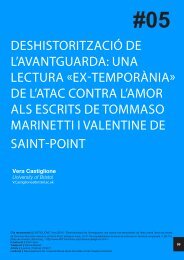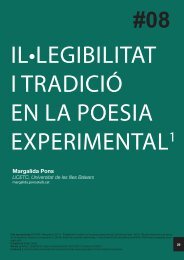03 - 452ºF
03 - 452ºF
03 - 452ºF
Create successful ePaper yourself
Turn your PDF publications into a flip-book with our unique Google optimized e-Paper software.
Early Modern period in conjunction with more recent popular culture<br />
references such as The Wizard of Oz (1939) and Bewitched (1964-<br />
1972). Yet, the series also comments on the gender implications of<br />
that image. Therefore, I will be examining the ways in which The<br />
Simpsons has attempted to answer Lisa’s question concerning the<br />
role of gender in witchcraft and witch accusations, and propose that<br />
the various «answers» posed by the series actually mirror not only<br />
current theoretical work on the witch but also reflect the ambivalence<br />
about the role of women in modern American society.<br />
1. «I’ve grown a costume on your face» from «Treehouse<br />
of horror XVI»<br />
The third vignette in the 2005 Halloween episode offers perhaps<br />
the most conventional representation of the witch in The Simpsons’<br />
history. For that very reason, it is a good place to begin this analysis,<br />
as it portrays the witch according to her most popular construction<br />
and presents a theory of the gender question that is also widely-held.<br />
The segment opens with Springfield holding a Halloween costume<br />
contest. In the crowd, Lisa can be seen dressed as Albert Einstein,<br />
Dr. Hibbard as Dracula, Ned Flanders as a flower, and, most notably,<br />
little Maggie as a witch (whose costume is only clear from her pointy<br />
black hat; otherwise, she is dressed in her traditional blue nightgown).<br />
On the steps of the town hall, Mayor Quimby announces a woman<br />
who strongly resembles the recurring character widely known as<br />
«The Crazy Cat Lady» dressed in a witch’s costume as the winner.<br />
However, when asked her identity, she is forced to admit that she is<br />
not wearing a costume, saying: «I’m a real witch». The town’s people,<br />
who by the way are in no way shocked by the existence of a witch,<br />
are outraged that she has cheated and they rescind her prize—a<br />
$25 gift certificate to Kwik-E-Mart, which its owner Apu readily admits<br />
is not enough to purchase anything in the store 2 . In her anger, she<br />
casts a spell on everyone who lives in Springfield, forcing them to<br />
«become the guise [they] don». Instantaneously, Marge becomes<br />
a skeleton, Bart a wolf man, and Grandpa Abe a gorilla. As most<br />
in the town are distressed by this turn of events, Lisa as Einstein<br />
sets out to find a solution. When Maggie, now dressed in a complete<br />
witch’s costume, is able to move objects with a spell, Lisa realizes<br />
that Maggie has the power to conduct counter-magic and undo the<br />
hex. Unfortunately, Maggie has no interest, or understanding, of the<br />
real issue at hand, and instead turns everyone into a pacifier—her<br />
true desire. The episode ends as she flies off on her broom, witch<br />
«dust» surrounding her, and the Bewitched theme music playing in<br />
the background.<br />
NOTES<br />
2 | Note that this slight against<br />
the witch, although petty, is<br />
deemed important enough to<br />
conduct maleficium. Sharpe<br />
notes that «however trivial the<br />
altercation», it could be viewed<br />
as the instigation of black<br />
magic (1996: 62).<br />
The Simpsons, Gender Roles, and Witchcraft: The Witch in Modern Popular Culture - Sarah Antinora<br />
<strong>452ºF</strong>. #<strong>03</strong> (2010) 115-131.<br />
118










